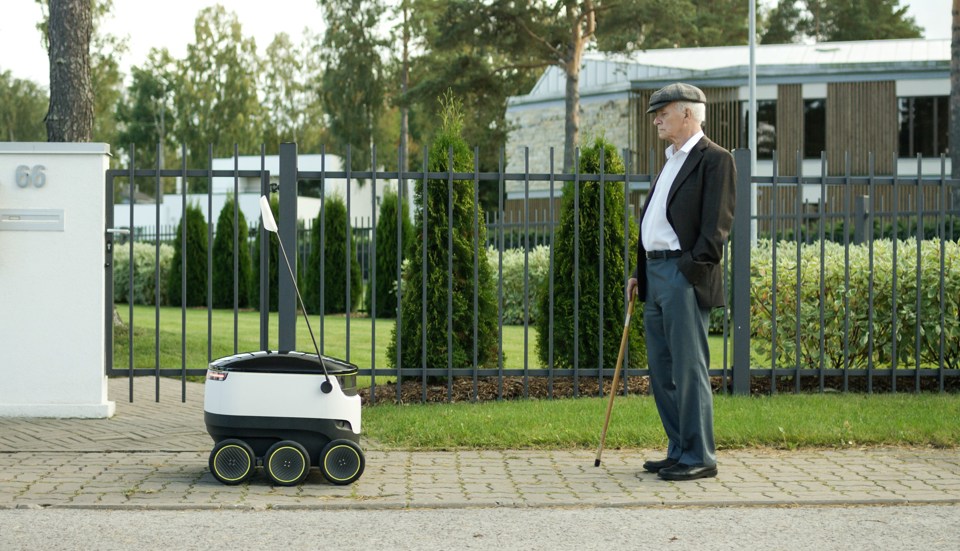Starship Technologies has said its autonomous delivery robots, currently on trial with Hermes in London, will act as “one of a raft of solutions” rather than a replacement for the entire delivery industry in the UK.
Hermes has started trialling the robots in Southwark to act as an alternative to vans and drivers for last-mile delivery in the suburbs.
Henry Harris-Burland, Starship Technologies vice president of marketing, told Fleet News: “We’re not suggesting these robots will replace the entire delivery industry. This is strictly for last-mile delivery in suburban locations and it is part of a raft of solutions companies can use in addition to their traditional fleet of vehicles.”
Starship estimates that its robots (first revealed in sister magazine Commercial Fleet in May 2016) can reduce shipment costs by up to 93%, although Harris-Burland said data from trials in the UK would be used to inform cost savings for companies based here. He would not confirm how long the trial will be running for or how many robots are part of the shared fleet.
However, having seen first-hand the success the robot fleet is having with food delivery trials for Just Eat in London, Carole Woodhead, Hermes UK chief executive, said: “We are excited to team up with them in a bid to revolutionise the home delivery marketplace.”
Initially, the trial will allow Hermes to offer 30-minute time slots for the collection of parcels, either for items being returned, or for items being sent by small businesses or consumers.
Woodhead said: “We will use the testing period to better understand how the robots could enhance the company’s ability to offer an increased range of on-demand solutions.”
Starship owns all the robots and handles management, operation, maintenance and charging (see panel below).
Access to the fleet is through a subscription service. This can either be per delivery or a monthly fee, dependent on a company’s needs.
The technology company says this allows subscribers to use the service according to seasonal peaks and troughs. However, Starship preferred not to reveal its prices.
During the Hermes trial in London, the robots will be accompanied by a member of Starship’s team to monitor their journeys and gather data.
If Starship’s trials with UK companies are successful, the plan is to have one operator monitor several robots at the same time working from a control centre where they will be able to take direct command of the robots if necessary.
Harris Burland said the robots will operate primarily in suburban locations where footpaths are not used as much as in city centre locations. Permission has been gained from local authorities and police have been informed of the trial.
Harris-Burland admits the likelihood of the security-protected robots being tampered with is high, but so far, there have been no problems.
How do the Starship robots work?
Each six-wheel Starship robot is just over half a metre high and less than a metre long with a secure compartment for parcels up to a maximum weight of 10kg. They can travel up to a walking speed of 4mph and consumers can unlock the robot through a link generated by a smartphone app.
The robots can be used within a two mile radius from a control centre where they can navigate autonomously 99% of the time but can also hand back control to a human operator for extra help if needed.
A single charge can last for three hours. However, batteries are swapped when robots return to base to minimise downtime. The batteries are slightly bulkier in size than a modern smartphone and are being swapped manually during the trial phase. The battery swap process will eventually be automated.




















Edward Handley - 15/06/2017 08:26
The Starship Technologies delivery robots are a very interesting concept but they have an electric motor and wheels so are clearly "motor vehicles" and it is illegal to use a motor vehicle, other than an invalid carriage, on a pavement under the Highways Act (1835). It would also be illegal to use them on the road as they do not have registration plates, lights, etc.. Although it is a very old bit of legislation it is still on the statute book and the Government and Police have used the 1835 Act recently to prohibit the use of Segways and hoverboards, so it is interesting that these robots are being allowed to operate unmolested. Is it just that no Police Officer wants the hassle of being the first to arrest a robot and have to sort out the paperwork afterwards!